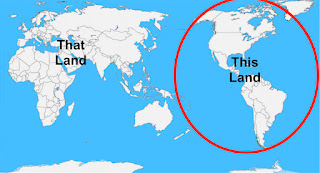Thus, the South Pacific Gyre is part of the Earth's system of rotating ocean currents, bounded by the Equator to the north, Australia to the west, the Antarctic Circumpolar Current to the south, and South America to the east. This means that in the area of Indonesia, the Pacific Ocean currents run east to west, or against any movement from there into the Pacific.
It must also be noted that ocean winds and currents are the most important part of sailing in ages past, before the invention of ships and sail arrangements that could sail close to the wind—or sailing in a direction close to that from which the wind is blowing, but still make headway.
Sailboat keel uses the forward motion of the boat to generate lift, which
counteracts the leeward force of the wind and converts the inherent sideways
motion of wind in the sails into forward motion
The first islands to encounter eastward from Indonesia are the Melanesia group, a sub-region of Oceania, extending from New Guinea island in the southwestern Pacific Ocean to the Arafura Sea and eastward to Fiji, which includes the four independent countries of: Vanuatu, Solomon Islands, Fiji, and Papua New Guinea, as well as the French special collectivity of New Caledonia and the Indonesian region of Western New Guinea.
In order for Polynesia to be expanded
eastward from Asia, the movement would have to pass through Melanesia
The point being that the indigenous people of the first islands encountered and all those between Indonesia and Polynesia, are black, whereas Polynesians are not. Yet, we are expected to believe that the same people out of Asia settled both areas, some becoming black and others not! In fact, DNA tests show that Polynesians are more closely related to Micronesians (far to the north) than to Melanesians, thus the claim is that Polynesians moved quickly through Melanesia, and did not leave much of a footprint in the land, while those who were Melanesians stayed in the land and settled. On such flimsy ideas are entire civilizations born in the minds of scientists.
In addition, for some reason, the last place to be settled by this fast-moving Polynesian people was the closer island areas of New Zealand, hundreds of years after the settlement of far eastern islands of Easter Island. It is also theorized that the Polynesians for some unknown reason bypassed two major areas, New Guinea and the Solomon Islands, and leap-frogged over them into the far Pacific on their march across the ocean.
There is also the knowledge that early Easter Islanders who were first encountered by Europeans, worshipped strange stone idols and Ra the Egyptian sun God. They also practiced an ancient birdman religion, a form of which is still found among the floating reed bed people of the Indus. They made reed rafts and they had a strange writing system akin to the ancient Harappa script.
The same type of carved and dressed stones
found in Peru are also seen on Easter Island, especially the specialty cut
stones to fill gaps
The red haired Paracas mummies and numerous legends of Peru all indicate that red heads were once a significant part of the population in Peru. The brownish-red-haired, green eyed, Araucano (Gold people) of Chile were one population that survived the onslaught of the Incas. Numerous other examples of Peruvian mainland factors have been found throughout Polynesia over the years.
Events that unfolded in Peru that led to the exodus of red heads into the Pacific can be read in the ancient Rongo Rongo text of Easter Island which was successfully deciphered in 1892 by Dr. Alan Carroll and describes the ancient history of Peru; however, this has not been accepted by mainstream science. Yet, his translation names the many tribes of Peru and their relationships with each other, their allies, their enemies and the wars fought that led up to the final exodus of the Puruha and Cha-Rapa people into the Pacific. His decipherment contains detailed information that would not have been available to him, unless he was reading it from an ancient source. Unfortunately, because this text did not say what the scientists wanted to hear, his valuable work and the Rongo Rongo text has been ignored.
Rather than try and fit round pegs in square holes, as archaeologists and anthropologist often do when they try to explain away matters by ignoring the most common and simple answers, and instead insert complex ideas that support their theories, why not look at this from a realistic point of view.
Sweet potatoes originated in Central and South
America. But archaeologists have found prehistoric remnants of sweet potato in Polynesia from about A.D. 1000 to A.D.
1100, according to radiocarbon dating
































